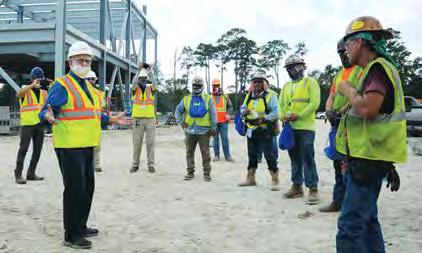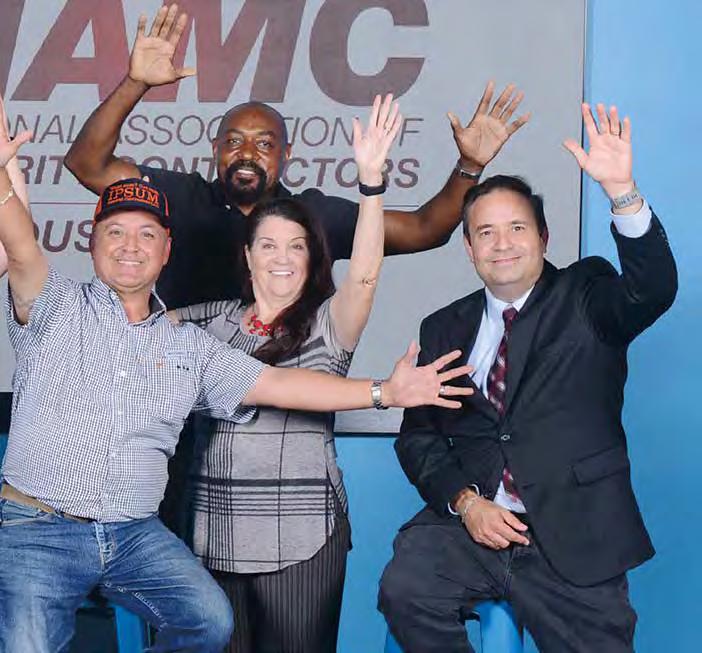
9 minute read
COVER STORY
By Subcontractors USA News Provider
The National Association of Minority Contractors Greater Houston Chapter has a mission to prepare and position deserving minority and female-owned businesses to win contracts, increase branding visibility and expand their client base through relationship development opportunities, and their efforts to complete this mission have not waivered despite the global COVID-19 pandemic.
NAMC Houston has gone 100% virtual in all their communication methods. Since March, they have created and sent out over 15 webinars and now conduct all meetings on Microsoft Teams platform. With tech help from MCA Communications, NAMC Houston was able to pivot to 100% virtual in just two weeks. Some of their virtual feats


include spotlighting four of their major corporate sponsors through a Microsoft Teams presentation to members and “lunch and learn” segments conducted by Roger Pombrel, NAMC Houston Education Chair.
They have adapted extremely well through this COVID-19 pandemic and have actually been able to improve communication efforts.
“We no longer have to rush through traffic to get to our meeting and presentation on time and can attend several virtual presentations in a day,” NAMC Houston Executive Director Abel Garcia said. “We also have almost 100% attendance at all our NAMC meetings.”
Membership growth is also exploding. From an impressive 50% in new membership increase in 2019, NAMC Houston will match that number by the end of September 2020 and expect around a 40% 2020 increase in new membership in 2020 over 2019.


FROM LEFT TO RIGHT: Greg Williams - Board Member, Abel Garcia – Executive Director, Maribel Rodriguez - Board Member, Ruben Mercado - Board Chair, Johnny G. Hollings - Board Member, Carol MacNeil - Board Treasurer, and Roger Pombrol - Exec. Vice Chair


Keith “MR. D-MARS” Davis, Sr. As CEO of Subcontractors USA-TEXAS, I am excited about our continued partnership with NAMC Houston. The Board and Executive Director of NAMC Houston have consistently grown the organization through their leadership and advocacy for minority contractors.


“The amount of construction is so great in the Greater Houston market that we need to continue to grow our minority crafts and companies to stay up with that 2020 and beyond growth,” Garcia said. “Small companies need the advocation, education and business opportunities NAMC brings to the table to be a growing service to that minority sector.”
NAMC Houston plans to bring the Biggest Event in Construction in 2020.
“NAMC and construction will bring Houston back to recovery via our ‘Day of the Construction Worker 2020 Event’,” Garcia said. “By conducting and filming an eightweek tour showcasing eight to 10 construction job site visits, they can spotlight and show thanks to Construction men and women. We can also share with Houston how these billions of dollars have thousands of men, women and suppliers contributing to our improving economy.” Garcia says NAMC Houston wants to be that “positive oasis in the middle of all this desert of sad COVID-19 pandemic news.” Construction has always played an important role of getting Houston back up on its feet disaster after disaster and this pandemic is no different.
“We want our unique ‘strong and can-do’ Houston back again,” Garcia said. “To NAMC that is the most important thing we can do for our construction men and women, industry and our great city of Houston!” For more info, visit namctexas.org
LEGAL
Factors to Consider When Deciding to Terminate for Default
By Subcontractors USA News Provider
Ageneral contractor’s young project engineer, frustrated with an underperforming subcontractor, asked an old superintendent why the company would not simply terminate the substandard subcontractor and hire another subcontractor to complete the work. The superintendent responded that if the company terminated that subcontractor and every other problematic subcontractor, eventually there would be no more subcontractors to work with. It seems like a simple answer, but owners, general contractors, and higher tier subcontractors often struggle with the decision to exercise their contractual right to terminate a lower tier entity for its inability to perform. This is often a difficult decision with no clear cut answer. The decision maker must consider several factors such as the ability to find a qualified replacement contractor/subcontractor; time and cost impacts; potential damage to the company’s reputation; and the uncertainty of heightened stakes. If the decision maker is involved in the day to day of the project, emotions may compromise the objectivity and integrity of the decision resulting in a detrimental impact to the project, the cost to complete, the ability to procure future work, and liability for the terminated party’s damages. Like the superintendent’s response to the project engineer, it is often best to play the long game, to leave emotions out of the decision to the extent possible, and to be sure that the decision to terminate is based on the proper criteria sufficient to survive the likely resulting litigation.
This article discusses a recent Court of Federal Claims decision in Alutiiq Mfg. Contractors, LLC v. United States where the Court analyzed the Government’s Contracting Officer’s (CO) decision to terminate a Contractor for default and ultimately held that the CO’s decision was wrong. Although this case pertains to the Federal Government and related Federal Acquisition Regulations, owners, general contractors, and higher tier subcontractors on private or public projects can take away some lesson from the Court’s analysis that may prove useful the next time they grapple with the decision to terminate an underperforming party for default.
The Project in the Alutiiq case was a classic problem project from the start. There were no innocent parties, and all lost in the end. Personalities clashed, several unresolved issues festered, snowballed, and concluded with the CO terminating the Contractor for default – resulting in the time-critical runway project completing more than a year late.
The Contractor struggled and delayed the Project from the outset by understaffing the project with incompetent management; failing to timely submit an acceptable CQC plan six times; failing to submit routine documents required by the contract; and, most importantly from the CO’s perspective, failing to find an asphalt supplier to provide asphalt conforming to the specifications. After the second cure notice, the contractor brought in better management, submitted a recovery schedule, and made modest strides in providing compliant asphalt. The CO decided the improvement was too little, too late and terminated the Contractor for default.
The Contractor’s problems seem typical of a Contractor spread too thin and in over its head. At first glance, the CO’s decision seems reasonable. But, the CO’s bias, wrongful actions, and failure to adequately justify his decision to terminate the Contractor for default ultimately proved fatal and the Court converted the termination to termination for convenience of the government.
Under Federal contract law, terminations for default are upheld if the court finds that the CO reasonably concluded that there was not a reasonable likelihood that the contractor could complete the project on time. There must be tangible, direct evidence reflecting the contractor’s inability to achieve timely completion. The Court’s analysis focuses on events, actions, and communications between the parties. Some courts compare the percentage of work completed and the amount of time remaining under the contract, the contractor’s failure to meet milestones, problems with subcontractors and suppliers, the contractor’s financial situation, performance history, and other pertinent circumstances surrounding the CO’s decision. These are factors every party should consider and document to support a decision to terminate an underperforming party.
Ultimately the Court found that the CO unreasonably concluded that the Contractor was unable to complete the project on time. The CO relied on an analysis of the baseline schedule instead of an adequate analysis of the recovery schedule; did not include an analysis of excusable delays; did not consider the urgent need for the runway and the amount of time it would take to procure a replacement contractor, or whether that contractor would complete the project at least as soon as the terminated contractor. The government also ignored improvement in the performance of the replacement personnel and the contractor’s ability to provide conforming asphalt. The Court

found that the “CO’s hostility towards the contractor and history of dishonesty undercut the [the government’s] ability to form an independent and reasonable belief regarding the contractor’s ability to complete the contract on time.”
Conclusion
In litigation or arbitration, the analysis will focus not only on the shortcomings of the underperforming party, but also on the actions of the terminating party and the factors that that party considered in deciding to terminate a contract. This opinion highlights the importance of objectively evaluating the likelihood and the ability of an underperforming party to improve its performance. While such evaluation should on some level be rooted in the past, parties should also carefully consider the merits and feasibility of the recovery plan. Perhaps the most important lesson an owner, contractor, and higher tier subcontractor can take away from this case is to be deliberate in administering the contract, help struggling parties where possible, and do not let their personal frustrations impact their decision to terminate a party for default. The decision has to make sense from the perspective of a reasonable third-party. Mistakes in this area can expose a company to significant liability often well beyond the costs of assisting a struggling party across the finish line.
Readers should not take or refrain from taking any action based on any information without first seeking legal advice.
Source: Associate General Contractor










